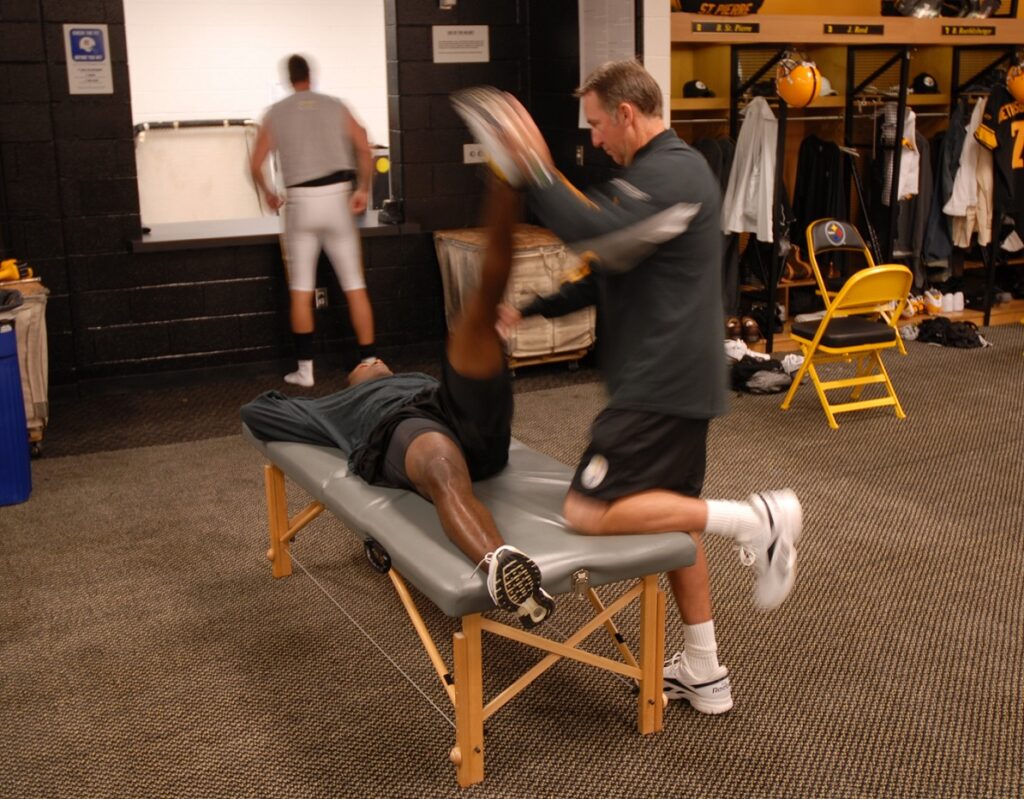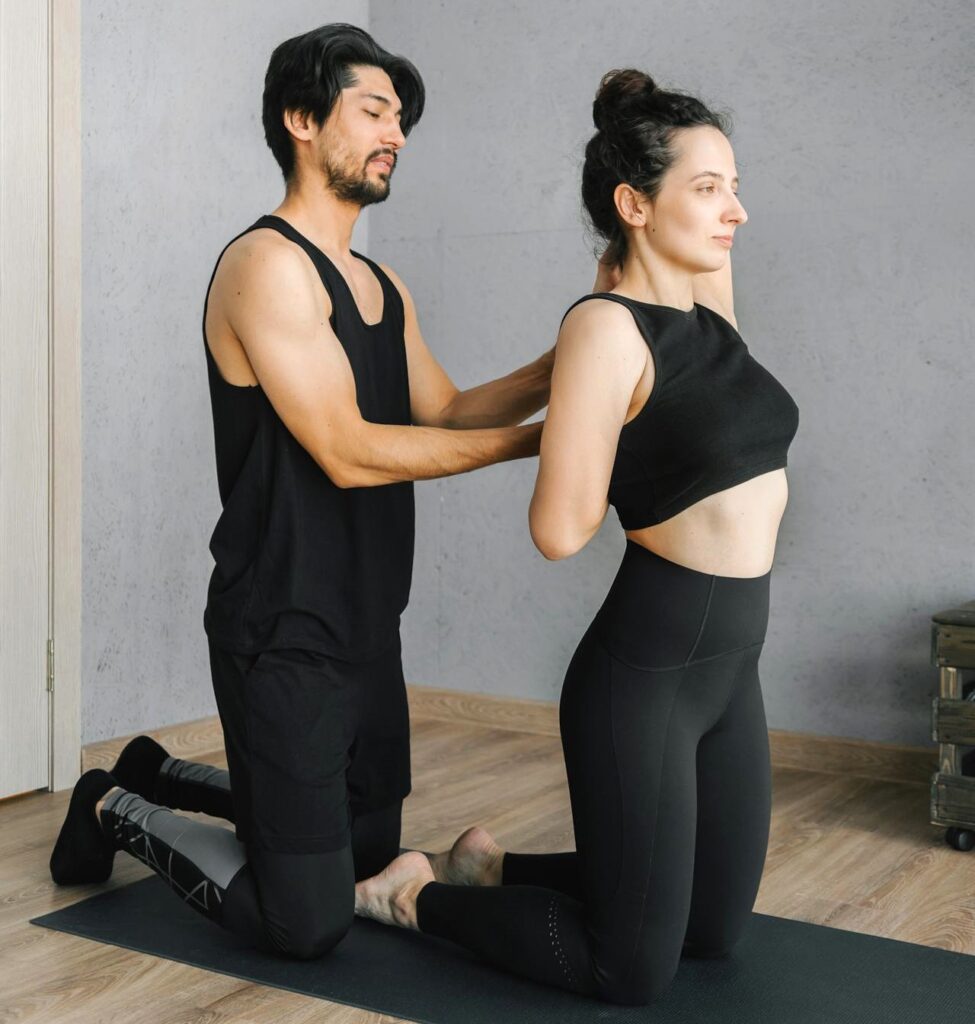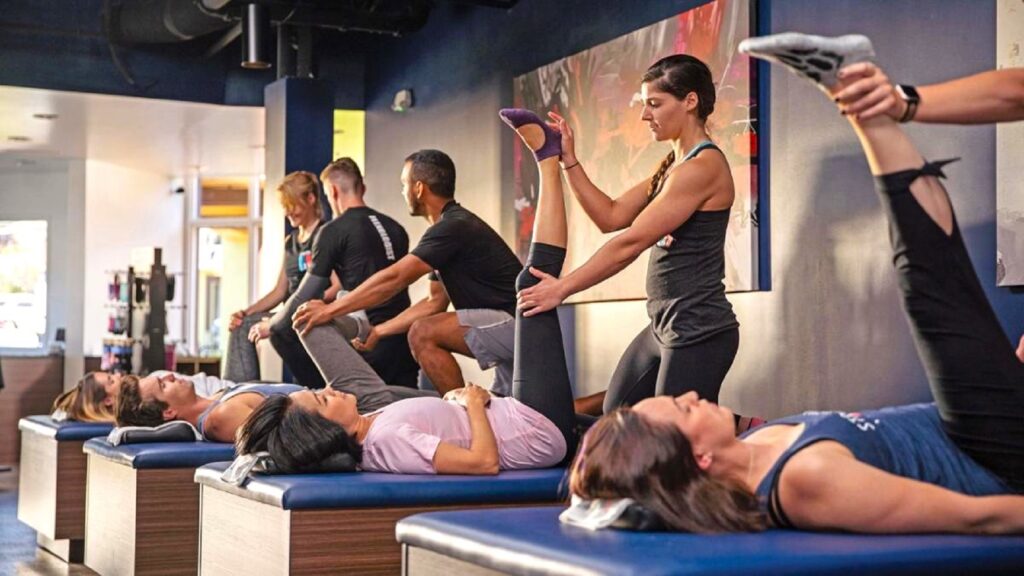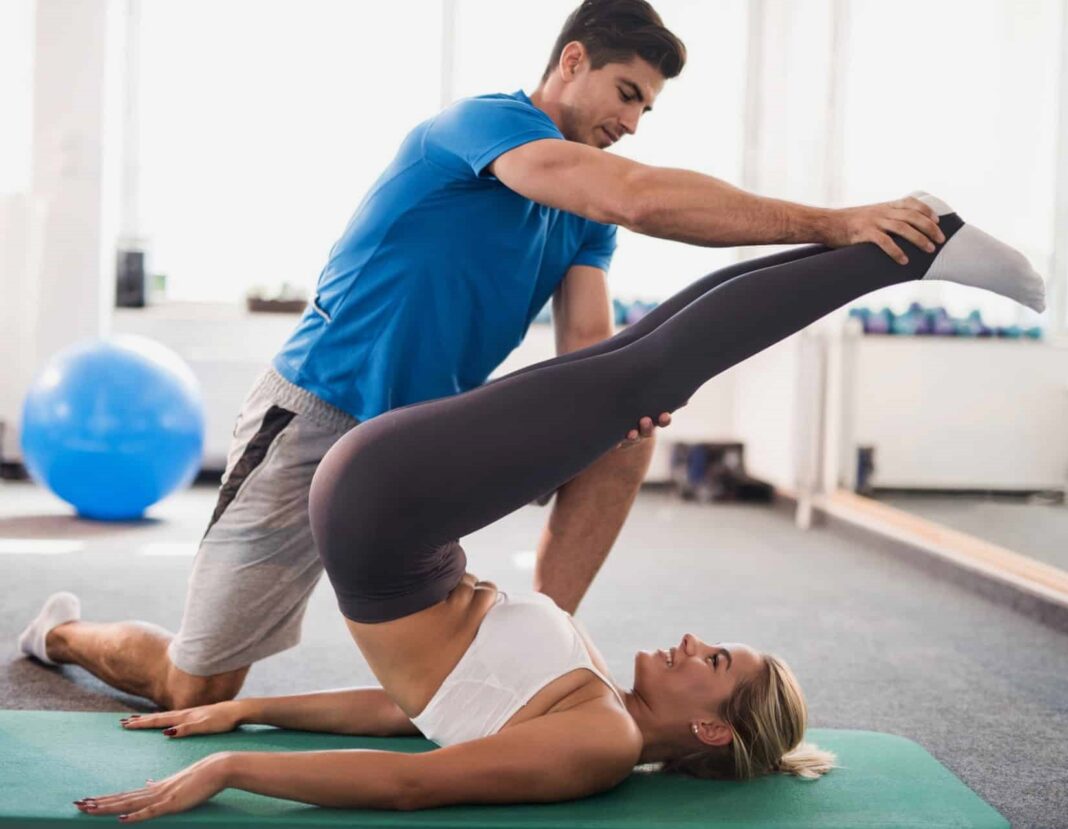Assisted stretching is hot. Business is booming. Stretchlab, Stretch Zone, and similar establishments are sprouting up everywhere, promising to improve flexibility, relieve pain, and boost athletic ability. The Barbell dives into assisted stretching to explain what it is, what the potential benefits are, how to do it, what to look for in a stretching partner, and much more.
WHAT IS ASSISTED STRETCHING?
Assisted stretching—also known as partner stretching, facilitated stretching, or stretch therapy—involves having a partner or a trained professional help you stretch your muscles and increase your flexibility.
ASSISTED STRETCHING BENEFITS
Improved Flexibility
It can help you improve flexibility by targeting specific muscle groups through a greater range of motion than you can achieve on your own. In turn, this increased flexibility can enhance your overall mobility and reduce the risk of injury.
Enhanced Relaxation
Assisted stretching can be a relaxing experience, as it allows you to fully let go and focus on the stretch without having to actively engage your muscles. This can help reduce muscle tension and stress. It can also help promote mental well-being.
Targeted Muscle Relief
A partner or professional can identify and target specific muscle groups that may be tight or otherwise in need of stretching. This can be particularly beneficial for individuals with muscle imbalances or chronic tension.

Better Posture
Performed regularly, it can help improve your posture by stretching and lengthening muscles that may have become shortened or tight over time. Proper posture is essential for preventing pain and discomfort.
Improved Athletic Performance
Partner stretching can safely allow for deeper stretches than you can get on your own. Better flexibility can boost athletic performance in and out of the gym, potentially increasing your speed, dexterity, and strength.
Injury Prevention
Increased flexibility and mobility can reduce the risk of muscle strains, ligament sprains, and other injuries. By addressing muscle imbalances and tension, assisted stretching can help maintain overall musculoskeletal health.
Pain Relief
For individuals with chronic pain conditions, such as lower back pain or neck pain, facilitated stretching can provide relief by releasing tension in the affected muscle groups.
Rehabilitation
Assisted stretching is often used in physical therapy and rehabilitation programs to help patients recover from injuries and surgeries. It can aid in restoring mobility and function.
Individualized Approach
Assisted stretching sessions can be tailored to your specific needs and goals. A trained partner or professional can assess your flexibility and design a stretching program that targets your problem areas.
HOW TO DO ASSISTED STRETCHING
Here’s a general guide on how assisted stretching is performed from the perspective of the person being stretched.
1. Warm-Up.
Before starting, you may want to warm-up your body with light aerobic activity to increase blood flow to your muscles.
2. Communicate.
Clearly communicate with your stretching partner. Discuss your goals, any specific areas of tightness or discomfort, and any injuries or limitations you may have.
3. Position Yourself.
Position yourself so that both of you are comfortable. Lying on a padded bench or table is ideal.
4. Relax.
Relax your muscles and focus on your breathing. Deep, slow breaths can relieve tension and thus enhance the effectiveness of the stretching.
5. Go Gradual.
Begin with gentle stretching and gradually increase the intensity.

6. Control The Movements.
The movements should be slow, consistent, and controlled by the stretch partner. Sudden or jerky motions that could lead to injury should always be avoided.
7. Hold Stretches.
Each stretch should be held for at least 15-30 seconds to allow the muscles to relax and lengthen.
8. Work The Range Of Motion.
Include range of motion exercises to promote flexibility. This may involve moving a joint through its full range of motion while your partner provides gentle resistance.
9. Be Passive And Active.
Incorporate both passive and active stretching. Passive stretching involves your partner moving your limbs, while active stretching involves you contracting and relaxing your muscles during the stretch.
10. Be Mindful Of Pain.
Stretching should not be painful. Communicate with your partner about the level of discomfort you are experiencing so they can adjust the intensity accordingly.
11. Cool Down.
After the session, perform a cool-down to help your muscles relax. This may involve gentle movements or static stretches.
12. Regular Assessment.
Assess your progress and make adjustments to your stretching routine as needed. If you experience pain or discomfort after stretching, inform your partner.
HOW TO FIND THE RIGHT ASSISTED STRETCHING PARTNER
Stretching is a booming business, but how do you find the right business or partner? Here are some suggested steps for hiring a professional.
Seek Recommendations.
Ask for recommendations from others who may have experience with stretching or know someone who does. Consult with fitness trainers, physical therapists, or healthcare professionals who may be able to recommend a suitable stretching partner or provider.
Look For Qualified Professionals.
Consider working with certified personal trainers or fitness professionals who are trained in stretching techniques. Physical therapists, sports massage therapists, and yoga instructors may also have expertise in assisted stretching.
Research Online.
Search online for stretching providers or partners in your area. Many professionals and studios have websites or profiles on social media platforms. Read reviews and testimonials from previous clients to get an idea of the quality of service provided.
Interview Potential Partners.
Contact potential stretching partners or providers to discuss your needs, goals, and expectations. Ask about their qualifications, training, and experience in assisted stretching. Inquire about their approach to stretching, including any specific techniques, tools, or methods they use. Most stretching business have padded, elevated tables (much like massage tables) designed for stretching. Belts, straps, stability balls, and other tools may also be used.

Verify Credentials And Certifications.
Ask for proof of certifications, licenses, or training in stretching, flexibility, and related physical therapy fields. Check if they have liability insurance to protect both you and themselves in case of accidents or injuries during stretching sessions.
Ensure Compatibility.
It’s essential to feel comfortable with your stretching partner and to have good communication with them. Discuss your goals and any specific concerns or limitations you may have to make sure they can accommodate your needs.
Try A Trial Session.
If possible, start with a trial session to gauge whether the stretching partner meets your expectations and provides the level of assistance you require. Pay attention to their communication style, professionalism, and the overall experience.
Discuss Costs.
Determine the cost of stretching sessions and ensure it fits within your budget. Different providers may have varying pricing structures.
Trust Your Instincts.
If you have any doubts or reservations about a potential stretching partner, explore other options until you find someone you feel comfortable and confident working with. Remember that assisted stretching can vary in techniques and methods, so it’s essential to find a partner or provider whose approach aligns with your goals and preferences. Your choice of a stretching partner can greatly influence the effectiveness and safety of your stretching sessions, so take your time to make an informed decision.
ASSISTED STRETCHING FAQS
How long should an assisted stretching session take?
Typically about 30-60 minutes. Stretchlab, for example, has 25 minute and 50 minute sessions.
Is assisted stretching worth it?
That depends on your needs and the price. In general, we yes. If you workout regularly and/or have any flexibility issues, assisted stretching provides benefits over unassisted stretching. An assisted stretching partner can put you into efficacious positions you cannot achieve on your own.
How often should I do assisted stretching?
This is up to you and your budget, as there’s no downside to stretching frequently. If you have a gym partner that you stretch with after training, you could do it after each workout. However, if you’re going to a stretching studio for full sessions, anywhere from twice monthly to twice weekly is recommended.
What are the long term benefits?
Increased flexibility, improved posture and athletic performance, reduced stress, and pain relief are some of the top benefits. Long-term, a trained assisted stretcher can gradually increase your ranges of motion in areas like your shoulder joints.
What is assisted stretching called?
It’s also called facilitated stretching, partner stretching, practitioner stretching, or stretch therapy.
What is a stretch practitioner called?
There isn’t a universal term. Stretchlab goes with Flexologist®. Stretch partner is in common use. For professionals, we like stretch therapist.
What do you wear to stretching?
You can wear workout clothes, yoga pants, or any loose-fitting clothing.
Is assisted stretching safe?
It should be. Communicate with your stretch therapist if you begin to feel any pain.
Do you tip for assisted stretching?
Yes, you can and should tip for an effective assisted stretching session. A standard 15-20% will be appreciated.
Related content:
The Science of Stretching: When and How to Stretch for Optimal Benefits
















































